Motorcade is rollingpublished at 06:06 GMT
The motorcade carrying Trump and a pool of reporters is now moving. They'll be driven to helicopters that will then take them to the aircraft carrier.
We'll bring you more updates in a bit - stick with us.
US President Donald Trump addressed troops aboard the aircraft carrier, USS George Washington, which is stationed in Japan
He told cheering troops that he is not going to be "politically correct", adding that "if we're in a war, we're going to win the war"
Earlier, he signed a rare earths deal with Japan's newly elected prime minister Sanae Takaichi
He also had high praise for Takaichi as the two leaders heralded a "golden age" in their countries' alliance
Takaichi told the troops that Japan was "committed to reinforcing defence capabilities"
After Japan, Trump flies to South Korea, where he will meet the Chinese leader Xi Jinping
'If we're in a war, we're going to win the war': Trump addresses troops on US carrier in Japan
Edited by Yvette Tan in Singapore, with Shaimaa Khalil in Tokyo and Anthony Zurcher, travelling with President Trump
The motorcade carrying Trump and a pool of reporters is now moving. They'll be driven to helicopters that will then take them to the aircraft carrier.
We'll bring you more updates in a bit - stick with us.
 Anthony Zurcher
Anthony Zurcher
North America correspondent, travelling with the president
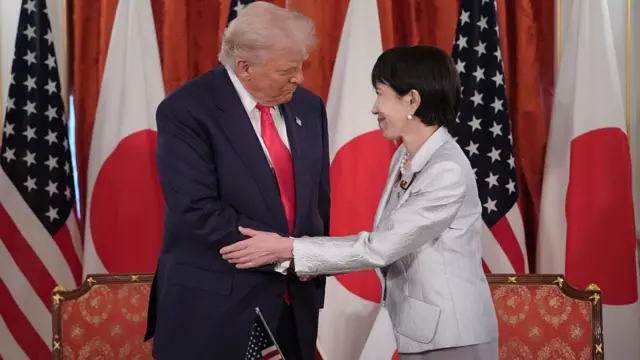 Image source, Getty Images
Image source, Getty ImagesTrump is getting what he wants out of this visit to Japan - praise, Nobel nominations and promises of foreign investment in the US.
While this is the first time he has met with the new Japanese prime minister, he appears to have developed an early rapport. The connection she had to Shinzo Abe, a Trump favourite, helped pave the way.
The pageantry and the venue also seemed tailor-made for the American president. A full military honour guard and band welcomed Trump to the ornate Akasaka Palace, with its vaulted ceilings and gold-encrusted walls not unlike what the president wants in his planned White House ballroom.
For those of you who are just joining us, we're following Trump who is currently in Japan meeting prime minister Sanae Takaichi as part of a diplomatic tour around the region.
Here's what you need to know to get you caught up:
Trump will arrive at the US naval base in Yokosuka later today, before meeting business leaders in Tokyo. We'll continue to bring you the latest as we get them - please stay with us.
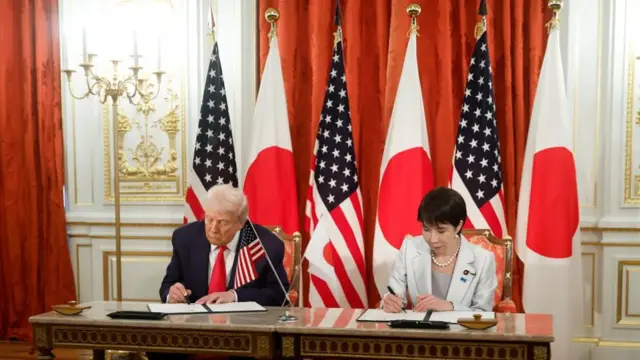 Image source, Bloomberg
Image source, BloombergThe trade agreement signed by the two leaders today promises a "new golden age" for bilateral ties.
What it actually does, though, is reaffirm previous agreements that they signed earlier this year.
This includes the US imposing a 15% tariff on nearly all imports from Japan, including its massive car industry - down from the 25% that Trump had initially threatened.
In exchange, Japan has pledged to invest $550bn in the US and buy more US goods, including in key sectors like cars, planes, agriculture and energy.
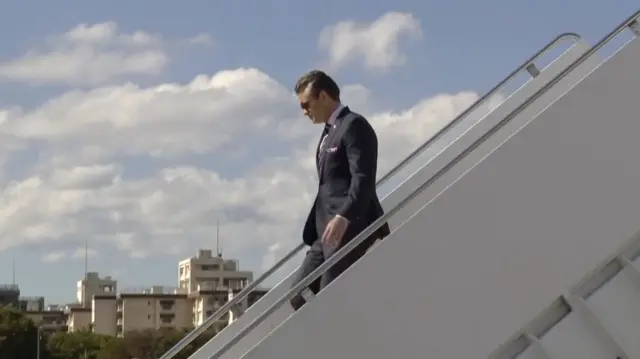 Image source, Reuters
Image source, ReutersUS Defence Secretary Pete Hegseth has arrived in Japan, where he was welcomed by his Japanese counterpart Shinjiro Koizumi.
He is scheduled to have a meeting with Koizumi on Wednesday.
As we reported earlier, security issues loom large over the agenda for Trump's trip to Japan. Trump has in the past repeatedly called on Japan to shoulder more of its security burden and increase defence spending.
During the working lunch, Takaichi also presented Trump with a map showing the investments that Japanese companies have made in the US, the White House said in a statement.
In July, Japan agreed to invest $550bn in the US as part of a trade deal to get the US to lower its tariffs on Japan.
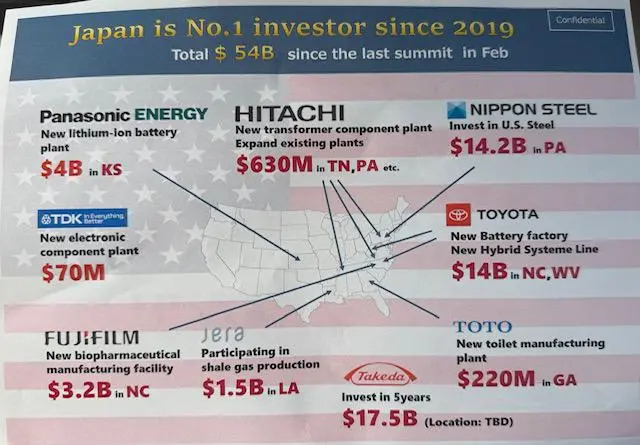 Image source, White House
Image source, White House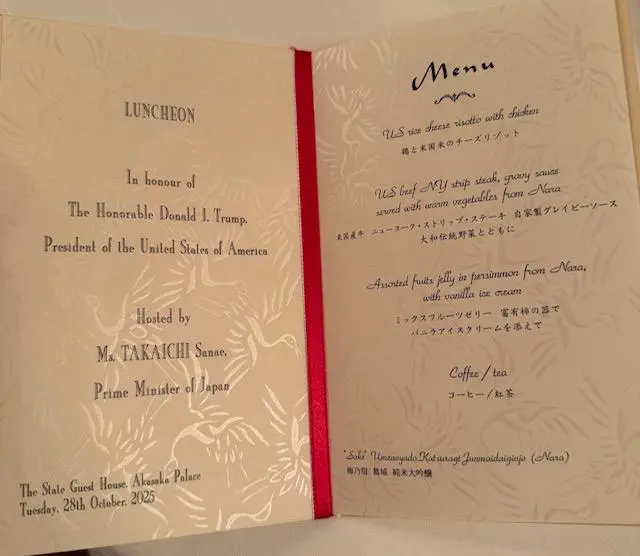 Image source, White House
Image source, White HouseHere's what's on the menu for Trump and Takaichi's working lunch:
The choice of serving American rice is notable, as Trump has repeatedly called for Japan to buy more US rice in the past.
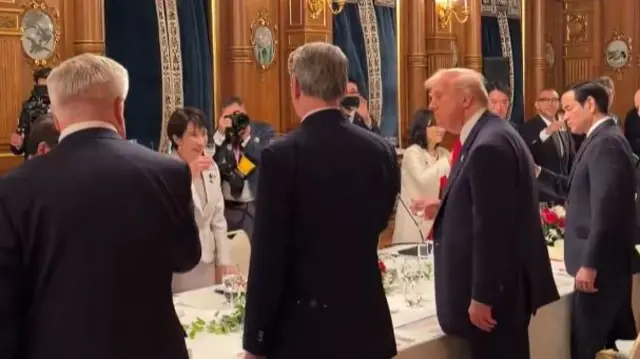 Image source, White House
Image source, White HouseThe White House added that Trump also "signed the lunch menus for the Prime Minister and the entire Japanese delegation, much to their delight!".
The two leaders were also seen sharing a toast.
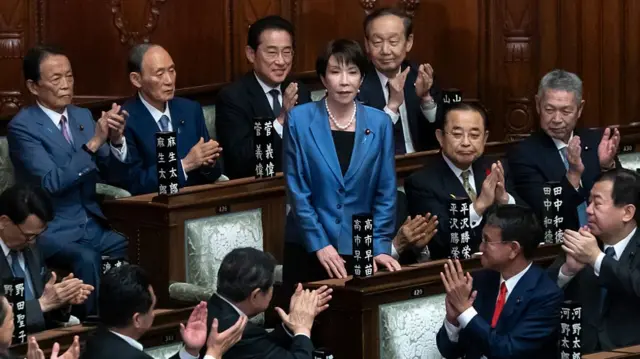 Image source, Getty Images
Image source, Getty ImagesJapan's new leader, Sanae Takaichi, aspires to become the country's Margaret Thatcher.
After two failed attempts, the 64-year-old Takaichi achieved her long-held ambition in a historic parliamentary vote on 21 October.
She's a colourful figure on the right of the governing Liberal Democratic Party (LDP), who talks tough on immigration and has some conservative views on women's equality.
A former government minister and TV host, and once a drummer in a heavy metal band, Takaichi will now face the challenge of leading not only a party struggling to regain voter trust after scandals and dealing with the burgeoning far right - but a country tackling a sluggish economy, low birth rates and rising geopolitical tensions.
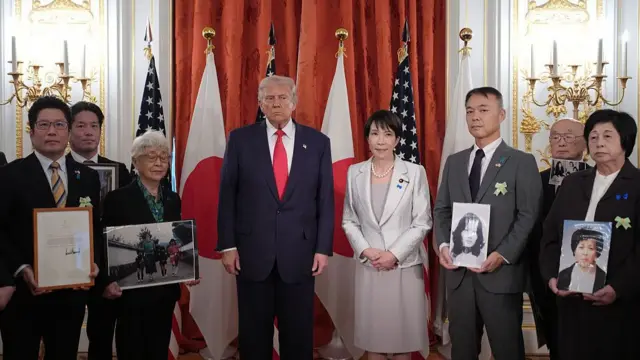 Image source, Getty Images
Image source, Getty ImagesTrump and Takaichi have just posed for a photo with the families of Japanese people who have been abducted by North Korea. The Japanese government says that North Korea kidnapped 17 Japanese citizens in the 1970s and 1980s - though some believe the real figure is much higher.
"I've met the families before and I'm with them all the way, and the US is with them all the way," Trump said.
"We have not done anything. We've been so busy," Trump said. "But we will do everything in our power."
The press pool traveling with President Trump has now moved back to the signing room with the families of Japanese citizens abducted by North Korea.
The issue of the abductions has stood between Tokyo and Pyongyang for decades.
According to the Japanese government, at least 17 citizens were abducted by North Korean agents between 1977 and 1983, although Pyongyang disputes that number.
The abductions are widely believed to have been part of North Korea’s espionage program. The victims were taken to train North Korean spies in Japanese language and culture.
Trump had met the families of the abductees during his first term.
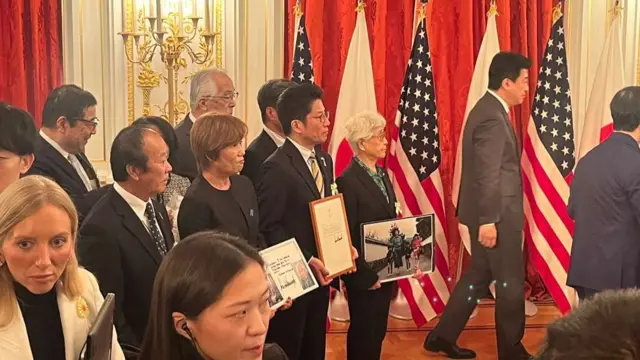 Image source, BBC/Anthony Zurcher
Image source, BBC/Anthony ZurcherTrump and Takaichi have signed an agreement, external to boost the supply and production of rare earths between the US and Japan.
The two countries agreed to cooperate through the use of policies, trade measures and coordinated investment to support the production of critical minerals.
Washington has been racing to diversify its supply of critical minerals to reduce its reliance on China, which holds a near-monopoly in the processing of critical minerals and has recently imposed export controls on them.
In recent days, the US signed a flurry of deals with Malaysia, Thailand and Australia on rare earths, which are needed for the production of most electronics, electric cars and military equipment.
Japan is known to have an abundant supply of rare earth minerals but much of it is underwater, making it difficult to mine.
Let's bring you a few more details on the "new golden age" deal that the US and Japan have just signed.
The agreement refers to previous deals the long-standing allies inked earlier this year which were about strategic investments and shared national interests.
Today's paperwork says that the two leaders "noted with satisfaction swift and continued efforts by both countries, and confirmed their strong commitment to implementing this GREAT DEAL".
The agreement will help both countries to "strengthen economic security, promote economic growth, and thereby continuously lead to global prosperity".
It also says that Trump and Takaichi have spoken to the relevant ministers and secretaries to "take further steps for a NEW GOLDEN AGE of the ever-growing US-Japan alliance".
Upon signing the documents on the "new golden age" of bilateral ties and cooperation on critical minerals, Trump praised Japan as an ally and commended Takaichi, the country's first female prime minister.
Japan, he said, is an "ally at the strongest level" for the US. He went on to describe Takaichi, who was elected last week, as "one of the greatest prime ministers", acknowledging the significance of her victory and calling it "a big deal" for Japan to have a female leader.
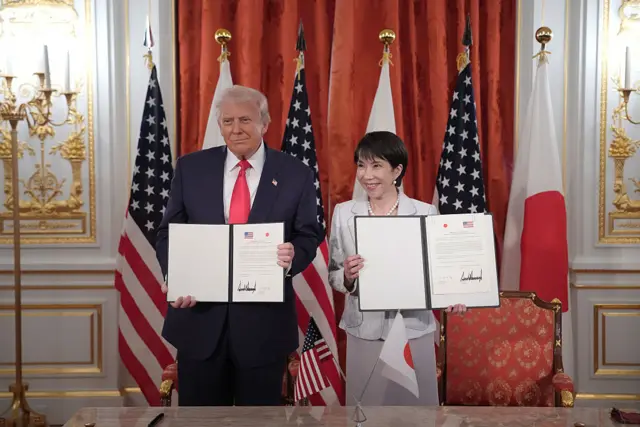 Image source, Getty Images
Image source, Getty ImagesTrump and Takaichi have just signed two new deals - one marking a new "golden age" of US-Japan relations and the other about a critical minerals deal.
The two leaders inked the agreements moments ago and have posed with the signed documents.
The first deal is about securing cooperation between the long-standing allies and the critical minerals agreement provides a framework to ensure the supply of rare earths.
 Shaimaa Khalil
Shaimaa Khalil
Tokyo correspondent
So far, one remark stands out. President Trump is affording Ms Takaichi a lot of good will.
"I want to just let you know - any time you have any question, any doubt, anything you want, any favors you need, anything I can do to help Japan, we will be there."
It’s a critical moment for Japan and for its new PM Sanae Takaichi - a defining early test of leadership. In her first face-to-face meeting with President Trump, she described him as a partner in a new golden age and praised his role in Middle East peace.
President Trump praised Japan as "a great ally" and said he’ll be there to help Japan whenever needed. But he’s also pushing hard on trade and security, leaving Tokyo backed into a corner.
Trump wants more US access to Japan’s markets - especially in cars, agriculture, and technology. He’s pressing Japan to buy more American rice and soybeans, and to open its market to US vehicles.
Tokyo, heavily reliant on exports, can’t afford a tariff fight - especially when it comes to its auto industry. But Takaichi also needs to protect domestic industries and doesn’t want to anger crucial interest groups like the powerful farming lobby.
For now, the tone is friendly. But there's real pressure on Tokyo to deliver on agreements with little room to manoeuvre.
Here are some photos from the Akasaka State Guest House, where Trump was received by an honour guard from Japan’s Self-Defense Forces.
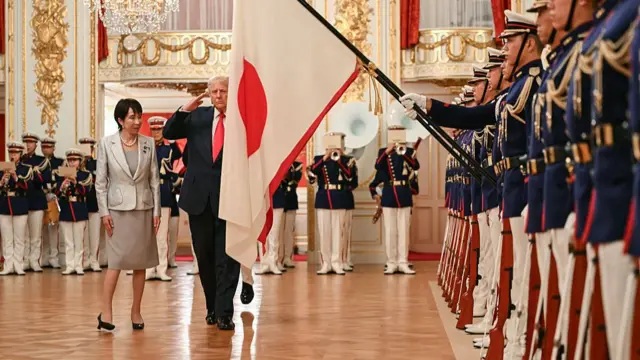 Image source, AFP via Getty Images
Image source, AFP via Getty Images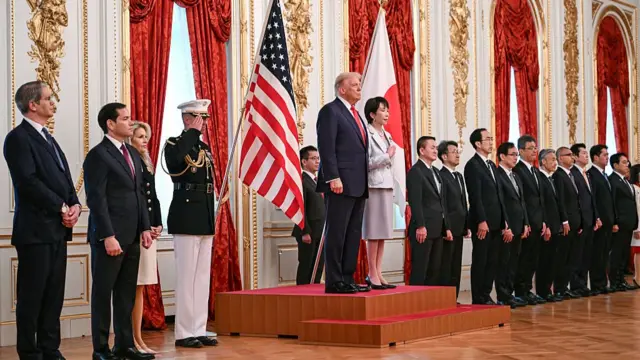 Image source, AFP via Getty Images
Image source, AFP via Getty Images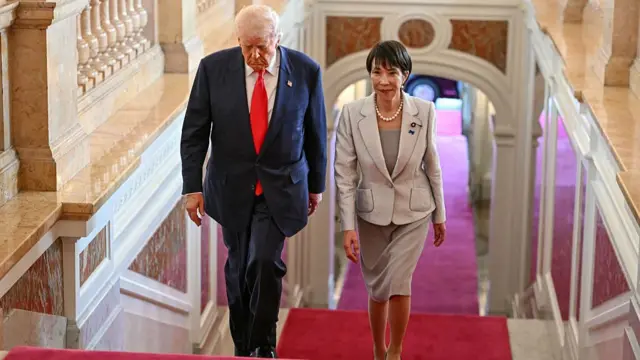 Image source, AFP via Getty Images
Image source, AFP via Getty Images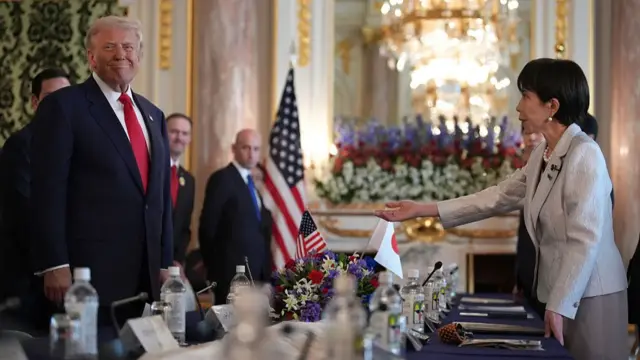 Image source, Getty Images
Image source, Getty Images Shaimaa Khalil
Shaimaa Khalil
Tokyo correspondent
Prime Minister Sanae Takaichi pledged Tuesday to build a "new golden era" of the Japan-US alliance together with President Donald Trump during their first meeting in Tokyo.
At the outset of the meeting, Takaichi also said the bilateral relationship has become "the greatest alliance in the world," while praising Trump's role in promoting peace in the Middle East.
A Japanese government source said Takaichi intends to tell Trump of her plan to recommend him for the Nobel Peace Prize.
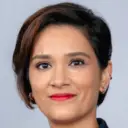 Suranjana Tewari
Suranjana Tewari
Asia Business Correspondent
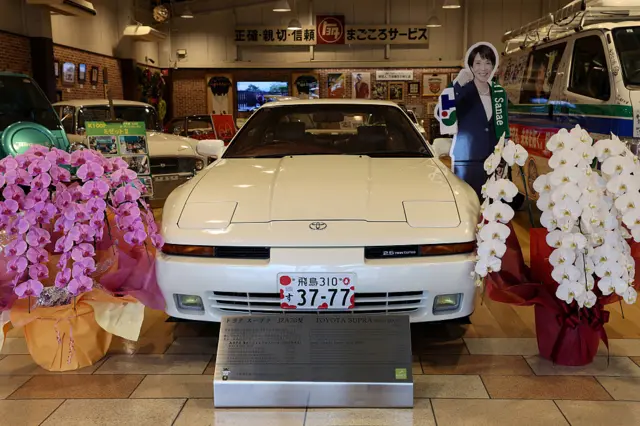 Image source, Getty Images
Image source, Getty ImagesJapan’s businesses were caught off guard when Trump announced sweeping tariffs on US trading partners in April.
Automakers – the country’s largest exporters to the US – faced 24% tariffs and tens of billions of dollars in losses.
Tariffs have now been lowered to 15%, in step with rivals in the region such as South Korea.
But the sector is lagging behind China as the world’s largest auto exporter, especially in the global transition towards electric vehicles.
And so the tariff chaos comes at a difficult time for one of Japan’s biggest and most lucrative industries.
 Suranjana Tewari
Suranjana Tewari
Asia Business Correspondent
Trump imposed tariffs of 15% on imports from Japan and forced its ally to commit to investing $550bn to “advance economic and security interests in the US”.
US Commerce Secretary Howard Lutnick is expected to flesh out those investments with Japanese companies during his visit.
So far, he has said the package would focus on areas such as power and pipelines that are fundamental to national security and have “virtually no risk”.
Tokyo has committed to buying around $8bn worth of agricultural products from the US, including soybeans.
Lutnick said tariffs on Japanese-made semiconductors and pharmaceuticals will remain at 15%.
Washington has pressed Tokyo to increase defence spending – something Takaichi seems open to.
The two leaders are also expected to discuss co-operation in shipbuilding, artificial intelligence and other technologies.
 Anthony Zurcher
Anthony Zurcher
North America correspondent, travelling with the president
Donald Trump’s meeting with Prime Minister Sanai Takaichi began with baseball, fireworks and cherry trees.
The Japanese have a cheering interest in the Los Angeles Dodgers, which features multiple Japanese stars. She said she and Trump watched a bit of the ongoing World Series upon his arrival.
Takaichi also noted that America would celebrate its 250th birthday next year - and promised gifts of cherry trees to Washington and Japanese made fireworks.
Trump seemed flattered by the gesture, although he was perhaps more impressed by Takaichi’s promise to increase Japanese defence spending to 2% of its GDP.
The American president said the US had no closer ally than Japan and noted that the late Prime Minister Shinzo Abe - who had become a good friend of his - had spoken highly of the new prime minister.